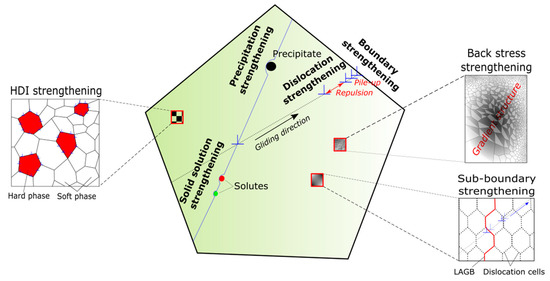Twinning-induced plasticity (TWIP) steel is a second-generation advanced high strength steel grade developed for automotive applications. TWIP steels exhibit an excellent combination of strength and ductility, mainly originating from the activation of deformation twinning.
- TWIP
- yield strength
- strengthening mechanism
1. Introduction
High Mn twinning-induced plasticity (TWIP) steel is a second-generation advanced high strength steel grade developed for automotive applications. TWIP steels are characterized by high Mn content ranging from 12 to 30 wt.%, and their main alloying elements besides Mn include C, Al, Si, etc. TWIP steels exhibit an excellent combination of strength and ductility due to the superior strain hardening behavior originating from the activation of deformation twinning [1,2]. The use of TWIP steels can result in a considerable weight reduction of steel components and a reduction of material use [3]. Further, the high energy-absorption capacity of TWIP steels is suitable for applications of crash relevant components in automobiles. However, TWIP steels generally have a relatively low yield strength (YS), which limits their practical applications. For example, the crash performance of TWIP steels can be outperformed by dual phase (DP) steels of the equal ultimate tensile strength (UTS) due to higher YS of the latter [4]. Considerable research has been conducted to tackle the issue of low YS of TWIP steels [5,6,7].
Classical strengthening mechanisms of metals include grain boundary strengthening [8], precipitation strengthening [9], solid solution strengthening [10], and work hardening [11]. Materials with high strength generally show ductility loss [12]. Various processing methods have been proposed to overcome the strength-ductility trade-off, which can be mainly divided into two directions: (1) Control of the thermomechanical processing [13,14,15]; (2) Application of novel processing methods to activate multiple strengthening effects [7,16,17].
The present work summarizes representative research works on the improvement of YS in TWIP steels by activation of multiple strengthening mechanisms as illustrated in Figure 1. With regards to novel processing methods, TWIP steels with high YS without losing ductility have been reported. For instance, dislocation cell structure [16], multi-phase structure [17], and gradient structure [18] lead to the effective strengthening of TWIP steels without significant loss of ductility.

Figure 1. Classical and novel strengthening mechanisms operative in TWIP steels. (LAGB: Low angle grain boundary, HDI: Hetero deformation induced).
2. Novel Processes to Improve the Yield Strength
) and recovery annealing was introduced by Haase et al. [62]. The material showed an ultrahigh YS of 1077 MPa and TE of 12.3%. The ultrahigh YS was originated from the nanocrystalline grains (<100 nm) and remained deformation twins generated during the ECAP process. In addition, the decrease of dislocation density upon recovery annealing slightly recovered strain hardening and ductility. Wang et al. [63] also reported for Fe-20Mn-0.5C-1.2Si-1.7Al TWIP steel that the combination of ECAP and annealing at 300 °C could result in excellent mechanical properties with YS of 1150 MPa and TE of 19%.
This entry is adapted from the peer-reviewed paper 10.3390/met11010124
